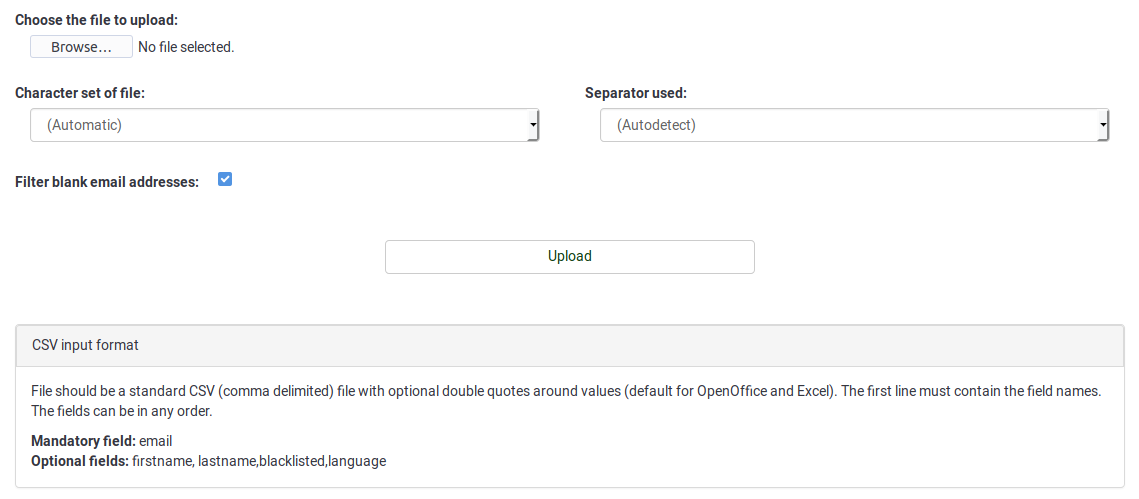Central Participant Database: Difference between revisions
From LimeSurvey Manual
mNo edit summary |
No edit summary |
||
| Line 65: | Line 65: | ||
*'''E-mail''' | *'''E-mail''' | ||
*'''Blacklist user''' | *'''Blacklist user''' | ||
*'''Owner''': Any user of LimeSurvey | *'''Owner''': Any user of LimeSurvey defined in the [[Manage_users#User_management|user control management page]] can be an owner. | ||
{{Note|Custom attributes can be added. For further details, see the [[Central participants database#Attributes|attributes section]].}} | {{Note|Custom attributes can be added. For further details, see the [[Central participants database#Attributes|attributes section]].}} | ||
| Line 124: | Line 124: | ||
<!--T:87--> | <!--T:87--> | ||
1) all participants in current search | 1) all participants in current search<sup>in progress</sup> | ||
<!--T:88--> | <!--T:88--> | ||
| Line 131: | Line 131: | ||
<!--T:89--> | <!--T:89--> | ||
3) only the participant's that I have selected | 3) only the participant's that I have selected | ||
<!--T:91--> | <!--T:91--> | ||
| Line 142: | Line 139: | ||
<!--T:95--> | <!--T:95--> | ||
After clicking | After clicking 'Next', you will be taken to the attribute map page. | ||
<!--T:96--> | <!--T:96--> | ||
The attribute map page has three columns and uses | The attribute map page has three columns and uses advanced drag and drop functionality. The first column shows all the attributes that are present in the central table. The second column gives space to the user to create new attributes. The third column shows the attributes in the token table to which the user is adding participants. The user is free to choose to either create a new attribute in the token table to copy new values to or map the values from the attribute located in the central table to the token table. | ||
<!--T:97--> | <!--T:97--> | ||
| Line 151: | Line 148: | ||
<!--T:98--> | <!--T:98--> | ||
After you have mapped all the attributes, you can click on continue | After you have mapped all the attributes, you can click on continue. After processing the participants, a summary page will show up that will tell you how many participants were successfully copied. If you have asked for redirection, you will be redirected to the token table table or else you will be redirected to the CPDB main page. | ||
<!--T:99--> | <!--T:99--> | ||
| Line 163: | Line 160: | ||
<!--T:22--> | <!--T:22--> | ||
1) ''Total participants in central table: | 1) ''Total participants in central table'' : The total number of participants located in the central participants database. | ||
<!--T:23--> | <!--T:23--> | ||
2) ''Participants owned by you: By default, the new participants entered into the central participants database have as owner the user that firstly added them. | 2) ''Participants owned by you'' : By default, the new participants entered into the central participants database have as owner the user that firstly added them. | ||
<!--T:24--> | <!--T:24--> | ||
3) ''Participants shared with you: | 3) ''Participants shared with you'' : The number of participants that were share with you by other users. | ||
<!--T:25--> | <!--T:25--> | ||
4) ''Participants you have shared: | 4) ''Participants you have shared'' : The number of participants you shared with other users. | ||
<!--T:26--> | <!--T:26--> | ||
5) ''Blacklisted participants'' | 5) ''Blacklisted participants'' : The number of blacklisted participants. | ||
<!--T:27--> | <!--T:27--> | ||
6) ''Total attributes in the central table'' | 6) ''Total attributes in the central table'' : The total number of attributes that can be found in the central table. | ||
==Import== | ==Import== | ||
If you wish to add participants via the import function, click on the Import button that is located on the main toolbar of the '''Central participant database''' page. The following options are available: | |||
[[File:Import CSV CPDB.png]] | |||
Please note the box on '''CSV input format''': | |||
{{Box|File should be a standard CSV (comma delimited) file with optional double quotes around values (default for OpenOffice and Excel). The first line must contain the field names. The fields can be in any order. | |||
'''Mandatory field: email''' | |||
'''Optional fields''': firstname, lastname, blacklisted, language}} | |||
<!--T:110--> | |||
===Steps to import=== | |||
<!--T:111--> | |||
1) Select a file to import and specify associated settings. | |||
<!--T:112--> | |||
<center>[[File:importCSV.png]]</center> | |||
<!--T:113--> | |||
2) Map the attributes in the CSV to those in the central table or create a new attribute. New attributes created will be of text box type but can be changed later. | |||
<!--T:114--> | |||
<center>[[File:attributeMapCSV.png]]</center> | |||
<!--T:115--> | |||
In the example screenshot I have created a new attribute age and mapped sex with the attribute in the central table. | |||
<!--T:116--> | |||
3) Wait for it to process and show the summary. | |||
<!--T:117--> | |||
<center>[[File:CSVsummary.png]]</center> | |||
<!--T:118--> | |||
Clicking ok will redirect you to the display participants screen showing the newly imported participants. | |||
==Export== | ==Export== | ||
<!--T:62--> | <!--T:62--> | ||
When exporting to CSV you are presented with a dialog box asking you to mark the additional attributes which you want to import. There is also an option for filtering the attributes. It will display all the attributes in the central table (visible/non-visible). | When exporting to CSV, you are presented with a dialog box asking you to mark the additional attributes which you want to import. There is also an option for filtering the attributes. It will display all the attributes in the central table (visible/non-visible). | ||
<!--T:63--> | <!--T:63--> | ||
| Line 205: | Line 237: | ||
<!--T:68--> | <!--T:68--> | ||
It will export the file as central_'the current time stamp'.csv . | It will export the file as central_'the current time stamp'.csv. | ||
===Export all=== <!--T:119--> | |||
<!--T:120--> | |||
This feature is for simplicity of the user. The user can click on it and can download all the participants that he has access to. | |||
<!--T:162--> | |||
Please note that this only exports participant attributes that are shown in the main grid. If you want to export hidden attributes please use the export button on the bottom of the main grid. | |||
===Advance search=== <!--T:69--> | ===Advance search=== <!--T:69--> | ||
{{Box|This function is not available in the last LimeSurvey releases (e.g. in 3.0). It will be reintroduced soon.}} | |||
<!--T:70--> | <!--T:70--> | ||
| Line 235: | Line 277: | ||
<!--T:80--> | <!--T:80--> | ||
<center>[[File:navBar.png]]</center> | <center>[[File:navBar.png]]</center> | ||
===Subgrid=== <!--T:104--> | ===Subgrid=== <!--T:104--> | ||
| Line 256: | Line 293: | ||
<!--T:109--> | <!--T:109--> | ||
This supports files with only *.csv extension. The rest of the settings are similar with what we have for "import CSV" under tokens. As in "add to survey" option we also have a drag and drop control over the attribute here. This feature scans all the headings in the CSV and shows them . You can map the attribute to an already existing central attribute or choose to create a new one. | This supports files with only *.csv extension. The rest of the settings are similar with what we have for "import CSV" under tokens. As in "add to survey" option we also have a drag and drop control over the attribute here. This feature scans all the headings in the CSV and shows them . You can map the attribute to an already existing central attribute or choose to create a new one. | ||
== Global participant’s settings== <!--T:121--> | == Global participant’s settings== <!--T:121--> | ||
Revision as of 12:38, 4 September 2017
Introduction
To access this option: Configuration->Central participants database

This feature allows the administrator to store the participant information to a central table that is independent of any token table. Its major advantages are:
- The central table acts as a backup. In the case in which a user creates a new survey, he does not have to go through the trouble of exporting its participants to a CSV file and then importing them back into a new survey.
- Users need only to add the participants to the central table. Then, the same participants can be added to as many surveys as the user wants.
- In case multiple users have access to a LimeSurvey installation, its owner(s) can choose to share his participants with other users and also set access rights for the shared users.
You may also find in your LimeSurvey installation an advanced attribute control and several other features.
The participants panel management tools
The following options are available:
- Display CPDB (Central Participant Database) participants
- Info
- Import
- Export
- Settings
- Attributes
- Share panel
Display CPDB participants
This is the main asset of the Participant's Panel. The great majority of options can be accessed from here, such as adding, deleting, exporting, adding to survey etc.

Five options are available in the Action column for every participant listed in the table:
- Edit this participant
- Delete this participant
- Share this participant
- List active surveys
- Add participant to survey
Add participant
After you clicked on the Add new participant button, a window will pop-up showing the following basic attributes:
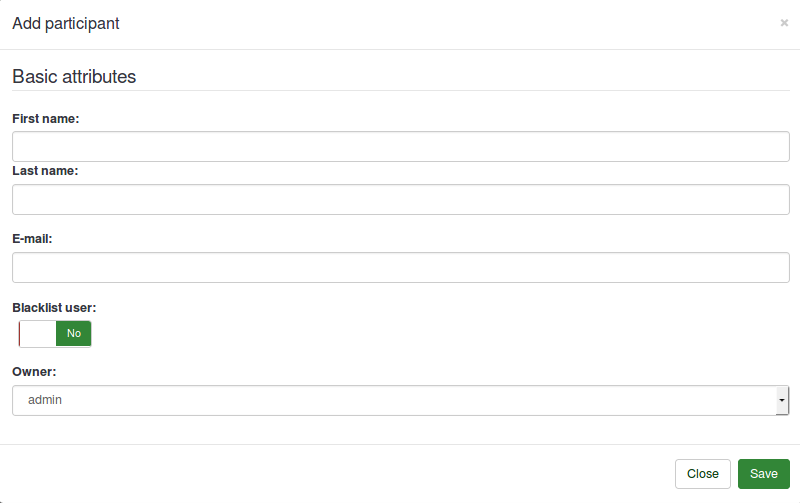
- First name
- Last name
- Blacklist user
- Owner: Any user of LimeSurvey defined in the user control management page can be an owner.
Edit this participant
To edit the basic and custom attributes of a participant, click on the first button (from left to right) located in the Action column. A window will pop up with the available attributes.
Delete participant
You can easily mark a single participant to delete or you can choose all the participants in the grid to be deleted. There are three possible conditions when deleting a participant.

The explanation of the three conditions is
1) Delete Participant(s) from central participants panel only
2) Delete Participant(s) from central panel and token tables
3) Delete Participant(s) from central panel,token tables and all associated responses
The first option deletes the participant from the central panel only. If the participant is in any token table, he/she will not be removed.
The second option deletes the participant from central panel and from the surveys where he has been added to, but his responses are not deleted.
The third option deletes all traces of that participant from the system, including his responses.
In all the three options the links created for the purpose of maintaining history related to a particular participant are also deleted.
This is another important feature of the Central Participants Database. You can share your participants with other users. You just have to select the participants you want to share and click on share. A modal box will open up which will allow you to select the user with whom you want to share.You can also set whether the user sharing your participant can edit those participants. If you set it no they will get an access denied error when trying to edit those shared entries.

List active surveys
If you click on it, all the active surveys where a participant has been added to will be listed.
Add participant to survey
Adding a participant to a survey can be done on three levels :
1) all participants in current searchin progress
2) all participants
3) only the participant's that I have selected

The title of the dialog box will show you the number of participants that are going to exported. Besides that, there is also a check box, that if checked, will take you to the token table of the survey to which you are adding the participants.
After clicking 'Next', you will be taken to the attribute map page.
The attribute map page has three columns and uses advanced drag and drop functionality. The first column shows all the attributes that are present in the central table. The second column gives space to the user to create new attributes. The third column shows the attributes in the token table to which the user is adding participants. The user is free to choose to either create a new attribute in the token table to copy new values to or map the values from the attribute located in the central table to the token table.
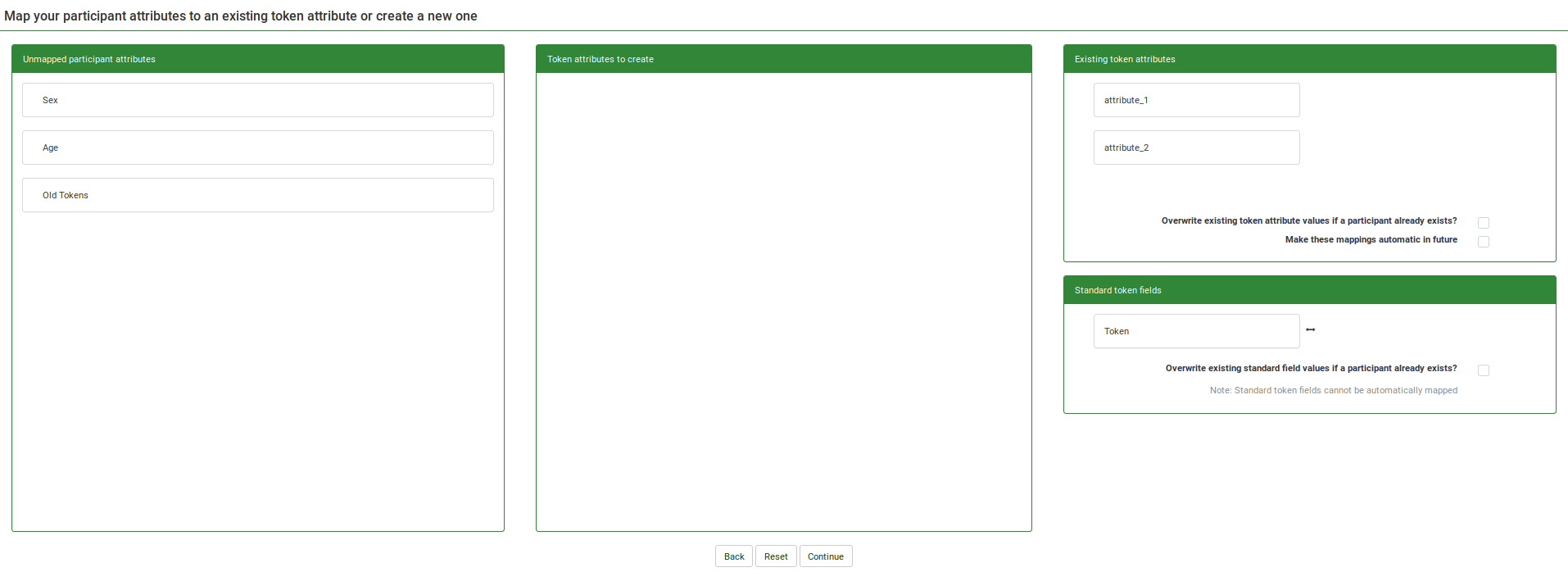
After you have mapped all the attributes, you can click on continue. After processing the participants, a summary page will show up that will tell you how many participants were successfully copied. If you have asked for redirection, you will be redirected to the token table table or else you will be redirected to the CPDB main page.
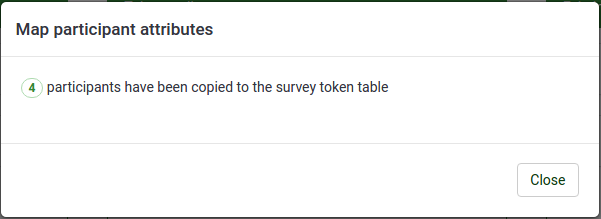
Info
It displays some Central Participate Database statistics:

1) Total participants in central table : The total number of participants located in the central participants database.
2) Participants owned by you : By default, the new participants entered into the central participants database have as owner the user that firstly added them.
3) Participants shared with you : The number of participants that were share with you by other users.
4) Participants you have shared : The number of participants you shared with other users.
5) Blacklisted participants : The number of blacklisted participants.
6) Total attributes in the central table : The total number of attributes that can be found in the central table.
Import
If you wish to add participants via the import function, click on the Import button that is located on the main toolbar of the Central participant database page. The following options are available:
Please note the box on CSV input format:
Mandatory field: email
Optional fields: firstname, lastname, blacklisted, language
Steps to import
1) Select a file to import and specify associated settings.
2) Map the attributes in the CSV to those in the central table or create a new attribute. New attributes created will be of text box type but can be changed later.

In the example screenshot I have created a new attribute age and mapped sex with the attribute in the central table.
3) Wait for it to process and show the summary.
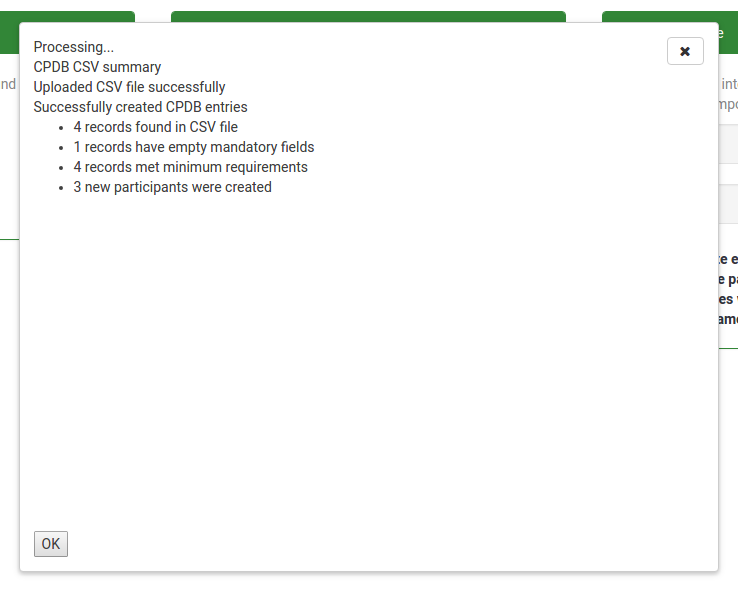
Clicking ok will redirect you to the display participants screen showing the newly imported participants.
Export
When exporting to CSV, you are presented with a dialog box asking you to mark the additional attributes which you want to import. There is also an option for filtering the attributes. It will display all the attributes in the central table (visible/non-visible).
The export to CSV option works under either of the two conditions :
1) Export filtered
2) Export All
It will export all or selected participants depending on your filtering criteria.
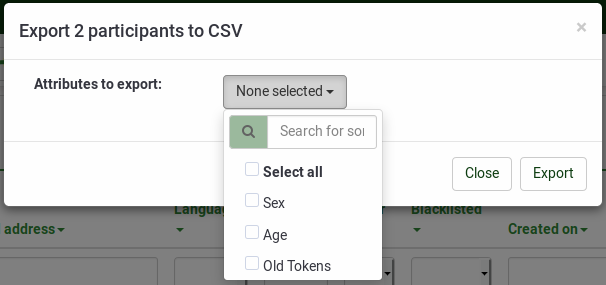
It will export the file as central_'the current time stamp'.csv.
Export all
This feature is for simplicity of the user. The user can click on it and can download all the participants that he has access to.
Please note that this only exports participant attributes that are shown in the main grid. If you want to export hidden attributes please use the export button on the bottom of the main grid.
Advance search
This is yet another major feature of the Central Panel. It is a powerful feature which not only filters through the participants but also through additional attributes (visible and non-visible). This feature is also integrated with the grid.
There are two levels of search that you can do.
1) Single search
2) Combined search
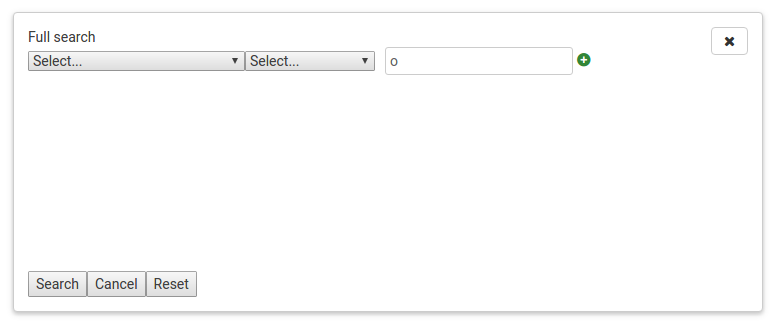
You can add a complex condition by using a plus sign next to the previous condition and remove a condition by using a minus sign in front of it.
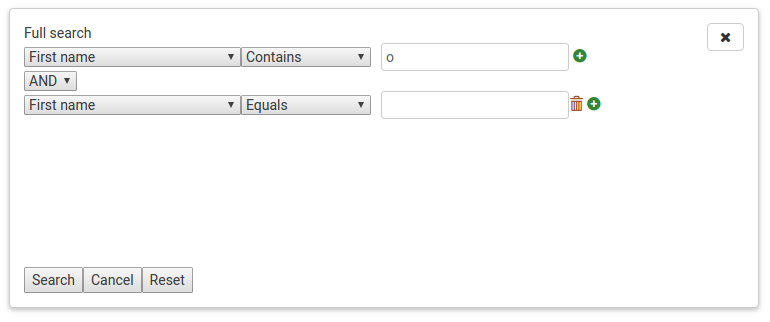
This not only filters the participants in the grid but also those in the database that are not yet loaded, so it is an extensive search.
Subgrid
For editing of attributes in the system we have implemented the concept subgrid in the main grid that shows all the attributes in the system and also allows you to edit them. The main grid shows only the visible attributes, the rest of the attributes are available here and only fetched when required. The subgrid as the main grid allows inline editing of attributes and also sorting. It also shows the links to the surveys to which the participant is added to. In case the participant is not added to atleast one survey, this subgrid is not displayed. When you expand the subgrid, all of the attributes in the system show up, but that doesn't means all the attribute values for that participant are saved in the database. Only when you add some value, that attribute value is saved for that particular participant.
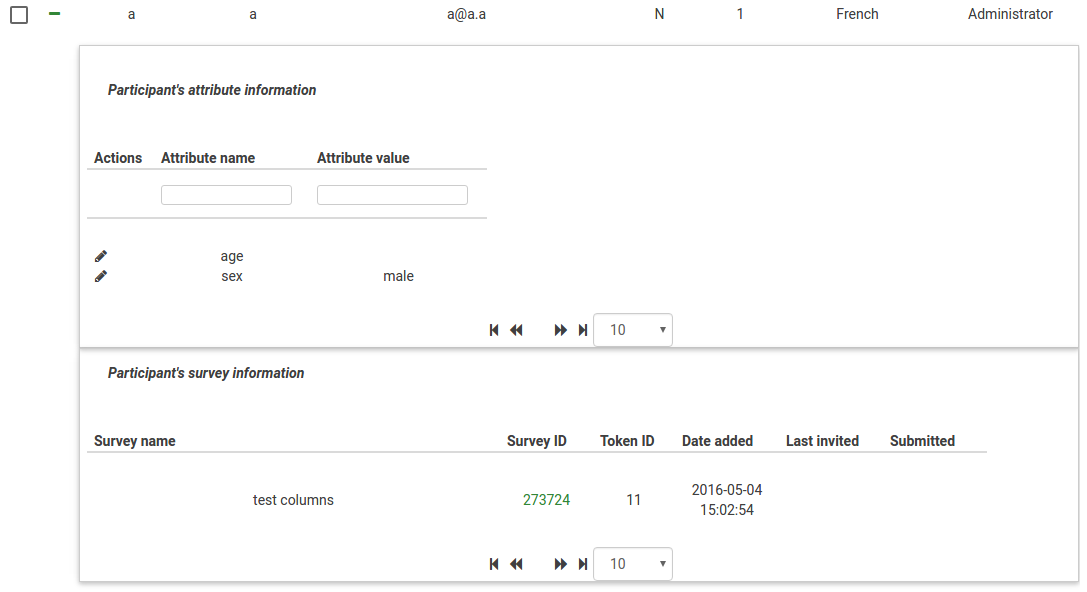
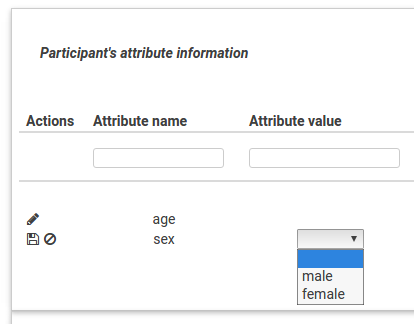
Import from CSV
This supports files with only *.csv extension. The rest of the settings are similar with what we have for "import CSV" under tokens. As in "add to survey" option we also have a drag and drop control over the attribute here. This feature scans all the headings in the CSV and shows them . You can map the attribute to an already existing central attribute or choose to create a new one.
Global participant’s settings
For security purposes the editing of user id is restricted, as it's the user id associated with the participant which decides the ownership of the participant. For this there is a setting in the main CPDB panel which can be changed only by the super administrator. If the setting is set to yes, you can edit the user name field in the display grid.

When you double click on the row, you can see a drop down in the owner name field where the list of all users in the system are listed and you choose which one to give participant rights to.

Attribute management
This is yet another advanced feature of the Central Participants Database. The attribute management in the token system allows to add only the attribute of text type, which reduces complexity, but when you have to add a large number of attribute values, it becomes very tiring to type the exact same value, for example 'male', repeatedly. To overcome this problem we have introduced three different attribute types :
1) Drop down
2) Text box
3) Date picker
You can choose either of the attribute types and associated UI will be presented to you while editing. For drop down , you will need to add possible values. Also, the attribute management has multilingual support.

As you can see there are already two existing attributes in the system. You can set their visibility right here by using the check box. The visibility will determine as to whether the attributes should be visible in the main grid or not.
For adding a new attribute you just have to click on the plus sign and a dialog will pop up, allowing you to put in basic details and saving the attribute.
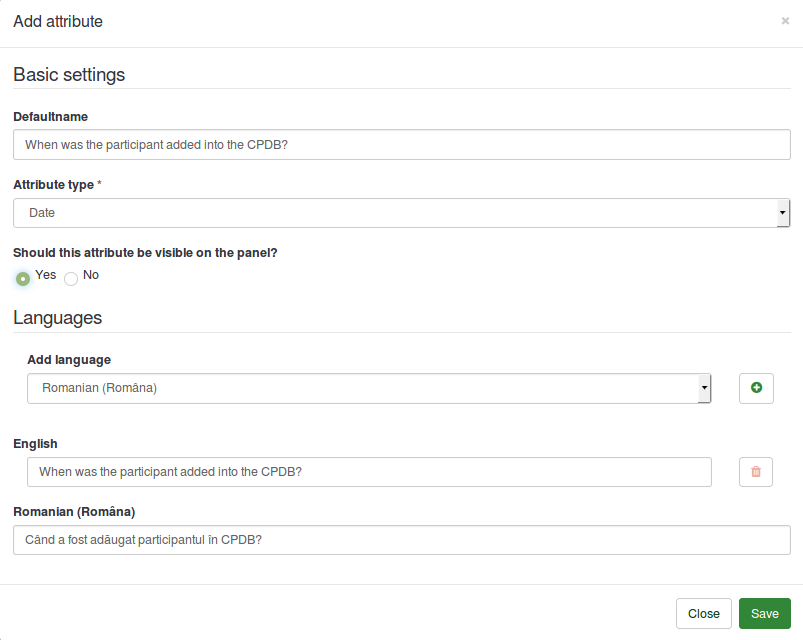
You can save the attribute by using the save button or by pressing enter after entering the attribute name.
For deleting an attribute in the system just click on the delete button next to the edit button. Clicking the delete button will not only delete the attribute but also the associated values.
For advanced editing, such as adding of drop down values and adding multilingual languages, you need to click on the edit button. On clicking the edit button you will see something like this.
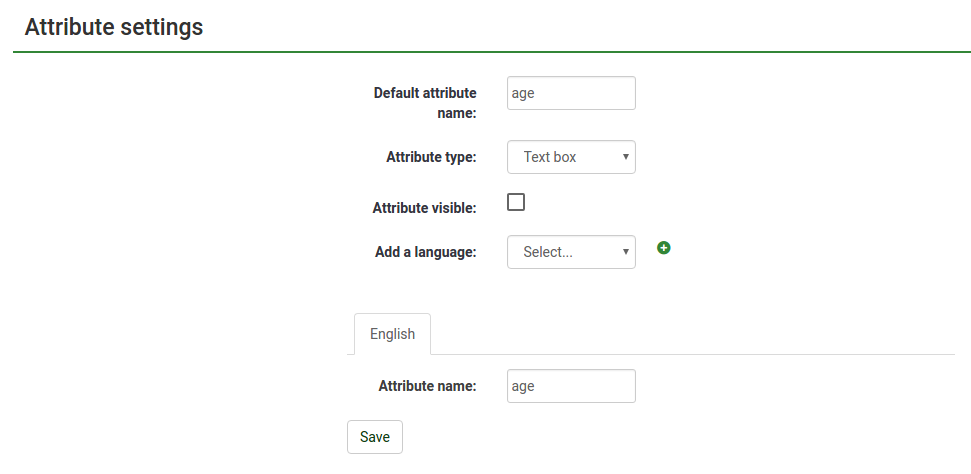
For adding a new language you can click on the plus sign and a new tab will pop up and you can add the attribute name in that language there.
You can also add drop down values by selecting the drop down attribute type.

You can edit the possible values of the drop down by clicking on the edit button or clicking on the value itself as it supports inline edit similar to what we have in the grid. Delete button is for deleting the specific value.
As you can see in the screenshots, the entire attribute properties can be edited here.
The share panel shows all the information related to the shared participant. Please note that this panel shows only the shared participants owned by that particular user.

This panel shows values like
1) First Name
2) Last Name
3) E-Mail
4) Shared With
5) Owner
6) Date Added
7) Can Edit
All this information is for viewing/sorting purposes only and only the "Can Edit" field is editable for the user. The can edit field as explained earlier determines whether to allow the shared participant to be editable by the sharer or not.Just clicking on the check box will make an AJAX call and save the changes on the server.
Panel summary
Panel summary is same as information, only it is loaded when the CPDB panel is opened and it can be accessed again by using the information icon in the toolbar.
Additional information
Additional (technical) information is available at Central participants database (User panel) Development.
